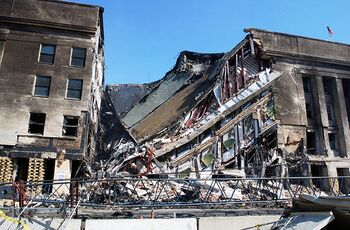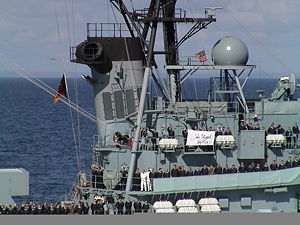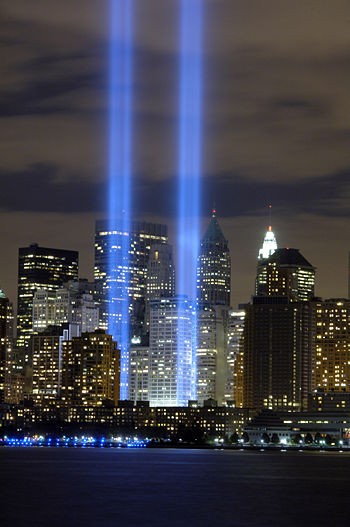9-11 Attack: Difference between revisions
imported>Howard C. Berkowitz |
imported>Howard C. Berkowitz |
||
| Line 81: | Line 81: | ||
==World response== | ==World response== | ||
The immediate threat was in Afghanistan, and within weeks NATO forces, led by American and British troops, invaded. This was the first invocation of Article 5, the mutual self-defense obligation of the NATO charter. | The immediate threat was in Afghanistan, and within weeks NATO forces, led by American and British troops, invaded. This was the first invocation of Article 5, the mutual self-defense obligation of the NATO charter. | ||
[[Image:LutjensHonors.jpg|thumb|300px|Lutjens on 9/11]] | |||
Responses came at all levels. The German [[destroyer]] ''Lutjens'', ironically named for the admiral who commanded the ''Bismarck'' on its final voyage, had been doing exercises, in the UK, with the US [[Burke-class]] destroyer ''[[USS Churchill (DDG-81)]]''. As ''Churchill'' got underway for emergency response, the ''Lutjens'' crew manned the rails, a naval custom showing respect. | |||
The 9-11 attacks ushered in a period of improved foreign relations between the United States and China and Russia, both of which see themselves as potential victims of similar attacks. | The 9-11 attacks ushered in a period of improved foreign relations between the United States and China and Russia, both of which see themselves as potential victims of similar attacks. | ||
Revision as of 13:43, 30 July 2009
The September 11, 2001, attacks were simultaneous terrorist attacks upon the United States of America on the morning of September 11, 2001. Nineteen members of the al-Qaeda terrorist network hijacked four commercial airliners, crashing two into the twin towers of the World Trade Center in New York City and one into the Pentagon in Virginia. The fourth plane crashed in rural Pennsylvania; its target may have been the U.S. Capitol or the White House. It was the worst terrorist attack in the history of the United States,[1] and indeed incurred more casualties than at the surprise attack at the Battle of Pearl Harbor.
The American response was near-unanimous support for President George W. Bush's eventual angry declaration that this was an act of war. Al-Qaeda was quickly identified as behind the attacks, with key figures located in Afghanistan. Congress quickly passed an Authorization for the Use of Military Force, which had the legal effect of a declaration of war.
The plot
The leaders of the plot were members of al-Qaeda, acting as part of its strategy against the West. The plot was devised by a veteran jihadist named Khalid Sheikh Mohammed (KSM), from a religious family in Kuwait, who had studied in the United States, which he hated violently. He helped his nephew plan the 1993 attack on the World Trade Center. In 1996 he went to Afghanistan to join forces with al-Qaeda, headed by Osama Bin Laden. It approved his scheme in 1999, and supplied guidance, collaborators, training, safe houses, and about $500,000 to finance the operation. All of the plotters had to speak the same language so Arabs were chosen from Saudi Arabia or Yemen; some were recruited in Germany, where they had become accustomed to Western customs.
Mohammed Atta was the leader of the attack force; he piloted the hijacked airliner that was first to strike a building. Ramzi Binalshibh, who had been denied access to the U.S., became KSM's chief assistant outside the U.S.
The key hijackers entered the United States legally in 2000. Two of the 19 and possibly 11 others presented fraudulently altered passports when they entered the United States. Mohammed al-Qahtani, who was refused admittance by U.S. immigration officials in August 2001, was identified by Khalid Sheikh Mohammed as the probably 20th hijacker. U.S. intelligence appears to accept that al-Qahtani, captured in Pakistan, and an admitted al-Qaida member, knew he was going into the U.S. for a suicide attack, but did not have specific prior knowledge of the exact attack.
The plan was to attack the World Trade Center as the symbol of capitalism, the Pentagon as the symbol of American power, and the Capitol or White House as the source of American policy supporting Israel.
The attack
The four hijackings were timed to be simultaneous. "Muscle men" overpowered and killed stewards and pilots with box cutters smuggled past airport security, while the new pilots turned off the transponders needed for air traffic control, and flew the planes, each loaded with over 20,000 gallons of fuel, toward the targets.
The North American air defense system, North American Air Defense Command (NORAD), did have a few fighter aircraft available, but no one had planned for airliners turned into weapons. The fighters were positioned for threats coming from outside the borders of North America. Domestic radar suitable for controlling fighters overland had long been shut down when Soviet bombers were no longer a significant threat; air traffic control uses transponders, not radar reflections. There was no simple way to find the airliners. With the transponder turned off, it would be necessary literally to read the number painted on the aircraft.
- Believed to have been hijacked at 8:14,[2] American Airlines Flight 11 was flown into World Trade Center North Tower at 8:46, under the control of Mohammed Atta
- United Airlines Flight 175 which hit the World Trade Center South Tower at 9:03, flown by Marwan al Shehhi
- American Airlines Flight 77 hit the Pentagon at 9:37, piloted by Nawafal Hazmi
- United Airlines Flight 93 crashed in a field in Pennsylvania at 10:03, after a struggle with passengers, flown by Ziad Jarrah
New York
On most days 50,000 people worked at the World Trade Center and another 40,000 had appointments there. The two planes struck at 8:46 am and 9:03 am when the North and South Tower buildings, 110 stories tall, were only half full. The towers survived the impact of the huge aircraft, but the burning fuel weakened the steel support systems, and both collapsed straight down, leaving a gigantic hole in lower Manhattan.
Other buildings in and around the complex were damaged, some beyond repair. The 47-story Building 7 was abandoned and collapsed. Its failure had wide-ranging effects, as it contained the main Emergency Operations Center for the city of New York. Even without the loss of the EOC, there were significant problems of coordination between emergency service organizations, especially the Fire Department of New York and the New York Police Department.
There were effects throughout New York. The immense dust cloud had long-term health effects, but, in the short term, quickly clogged the air filters of emergency electrical power generators at critical facilities elsewhere. Those facilities, such as Internet Service Providers, had a week or more fuel for their diesel generators, but had not stocked spare air filters, which were delivered on an emergency basis.
Many electrical, telecommunications and transportation facilities ran under the complex and were put out of action. A number of financial institutions had their real-time data centers in the buildings, although they quickly switched to backup.
The total number killed by the four plane crashes was 2900. The world gasped in disbelief at the attacks, which live television broadcast in horrifying detail. Sympathy poured in from across the globe—apart from some Middle Eastern lands where the onlookers cheered.
Americans were awestruck by the way New Yorkers pulled together in the face of the greatest disaster ever to hit their city. Despite some initial panic and claims of looting, many people took care of each other, and gathered in grief to honor the victims and help the survivors. From across the country fire and police departments sent rescue units as a symbolic gesture to honor the 343 firefighters and 60 police killed after they helped 25,000 people escape.
Washington
In Arlington, Virginia, the Pentagon Building was still a disaster, but not on the scale of the World Trade Center. Most important, of course, was that the building did not collapse. Many military personnel in the building immediately responded, while people in the damaged areas were, in some cases, able to rescue themselves. The Arlington, Virginia Fire Department took Incident Command, with the Federal Bureau of Investigation coordinating the overall interagency and law enforcement response.
Flight 93
The fourth plane had a delayed takeoff and passengers on board learned by cell phone what had happened to the other three planes. They organized themselves spontaneously and rushed the hijackers, who deliberately crashed the plane before reaching Washington. For years afterward the nation searched for overlooked clues.
Immediate Response
In the first minutes and hours, there were both operational and policy/political responses.
Operational
The Federal Aviation Administration, operating the national air traffic control system, first became aware of a problem with Flight 11 approximately 8:22 AM; analysis suggests the hijacking started at approximately 8:14. FAA Air Traffic Control asked another aircraft to look for Flight 11 at 8:37.[3]
First warnings
Command and control
President George W. Bush was traveling at the time of the attack; Vice President Dick Cheney made immediate operational decisions until Bush was at a remote command post. This is standard Continuity of Government procedure, at least the President or Vice President must go to a secure location.
At the White House, the Counterterrorism Security Group, chaired by Richard Clarke, coordinated the staff response.
As information was being gathered, all civil aircraft in the United States were ordered to land at the nearest airport, under an established but never-used emergency procedure, "Security Control of Air Traffic and Air Navigation Aids", SCATANA.[4] As planned, the FAA would actuate SCATANA in response to NORAD orders.
The military went to worldwide alert, and put available fighter aircraft over major cities.
Policy
David Frum, then a speechwriter for George W. Bush, called Richard Perle within minutes of the 9-11 Attacks. Frum had been, along with the rest of the staff, evacuated from the White House and was using Perle's office at the American Enterprise Institute. Perle said he cannot remember all the conversation, but he said that Frum said that President Bush should say "he will not distinguish between the individual terrorists and the countries that support them. I didn't identify the attack with a specific group since there are multiple groups that cheerfully could have done this. But I had felt for a long time that chasing individual terrorists was a losing proposition. Terrorists could hide, but the countries that accomodated them couldn't." [5]
Short-term political aftermath
Mayor Rudolph Giuliani was to many a hero to the city and the nation for his response in organizing rescue, relief and healing operations, making him "Person of the Year" for Time magazine and propelling him to a presidential run in 2008. Psychologically, the nation joined together in a unity that had not been seen since the end of World War Two. Long-standing hostility and ridicule of New York City burned away; there was no opposition to Congressional votes of $20 billion in aid to the city. Over a billion dollars poured in as voluntary contributions to help the families of the victims. Despite economic losses that approached $100 billion, the emergency repairs were quickly made and the economy of the metropolis never faltered. However the national aviation and tourism industries suffered heavily as people were afraid of future hijackings. The overall economy had already slipped into a downturn and 9-11 made the recession worse. Giuliani ran for the Republican presidential nomination in 2008 primarily on the basis of his performance in the crisis.
World response
The immediate threat was in Afghanistan, and within weeks NATO forces, led by American and British troops, invaded. This was the first invocation of Article 5, the mutual self-defense obligation of the NATO charter.
Responses came at all levels. The German destroyer Lutjens, ironically named for the admiral who commanded the Bismarck on its final voyage, had been doing exercises, in the UK, with the US Burke-class destroyer USS Churchill (DDG-81). As Churchill got underway for emergency response, the Lutjens crew manned the rails, a naval custom showing respect.
The 9-11 attacks ushered in a period of improved foreign relations between the United States and China and Russia, both of which see themselves as potential victims of similar attacks.
Homefront impact
McCartney, (2004) argues that America's strong sense of exceptionalism shaped US foreign policy following the 9-11 attacks. Utilizing the perception of the American people that the nation was destined by God to bring a new order to the world, President Bush portrayed America as the guardian of freedom and values all people cherish. Bush also identified as evil the terrorists and all those who opposed America's efforts to liberate oppressed people everywhere, and he justified the use of unilateral preemptive attacks on other countries, namely, Iraq, as necessary to ensure that the United States was able to fulfill its divine mission.
In terms of domestic policy the most important result of 9-11 was the passage in October 2001, by bipartisan majorities, of a law formally titled "Uniting and Strengthening America by Providing Appropriate Tools Required to Intercept and Obstruct Terrorism Act of 2001" (USA PATRIOT Act). The Patriot Act significantly enhanced the ability of law enforcement agencies to trace terrorist cells, especially those using the phone system or the Internet, to share information among many different security agencies, and to seize the financial assets used by terrorists. Civil libertarians worried that the PATRIOT act sacrificed some rights in the name of security.
Despite some fears that Americans would take out their frustration against Muslims inside this country, nothing of the sort happened. Law enforcement did increase their surveillance of foreigners from the Middle East, leading to debates about the wisdom of ethnic profiling. [6]
The second most important domestic result was the reorganization of multiple federal agencies dealing with terrorism. 22 different agencies with 180,000 employees merged into the Department of Homeland Security in the largest reorganization of the federal government in 50 years. The new department included the Secret Service, the Coast Guard, Customs, Immigration and Naturalization,, and the Transportation Security Administration (which took over airport security from private firms). Not included in the new department were the FBI and CIA. They remained independent, while promising better coordination and information sharing, as well as a redefinition of their primary mission as combating terrorism inside the United States and worldwide.
Memorials
Greenspan (2006) shows that vernacular and official practices dynamically intersected to create multiple narratives of September 11th . Specifically, narratives emerged out of groups', individuals', and institutions' negotiations over memorials' material and discursive qualities. Narratives on vernacular forms---homemade memorials at the WTC site created by visitors from around the world, testimonies during rebuilding hearings, and family members' private memorializations---marked multiple and contradictory histories of September 11th . They voiced senses of sadness and loss within and across national boundaries, alongside assertions of national power. Narratives on official forms---the site's viewing fence, designs for a future site, and September 11th museum exhibits---marked more monolithic and therefore exclusionary histories. They echoed themes of national strength but marginalized senses of loss and vulnerability, and representations of supranational components of the events. Further, groups and institutions strategically employed categories of "memory" and "history" to naturalize narratives that represented September 11th as "national", and marginalize narratives that represented the events over a supranational scale.
Ground Zero became an informal shrine, as New York's leaders debated how to handle the memorials and the rebuilding. Mayor Rudy Giuliani gained enormous prestige from his sensitive handling of the crisis, propelling him to a leading position in 2007 for the Republican presidential nomination in 2007.
Freedom Tower
Perhaps the greatest memorial to the attacks has not yet been completed. The New York City Freedom Tower, which will stand 1,776 feet tall on the site of the former World Trade Center, is the work of the Lower Manhattan Development Corporation. Those behind the project hope it will "serve as a beacon of freedom, and demonstrate the resolve of the United States, and the people of New York City".[7] The site will also feature the Reflecting Absence memorial, which will honor the 2,986 men and women who died as a result of the terrorist attacks.
References
- ↑ National Commission on Terrorist Attacks Upon the United States (also known as the 9-11 Commission) (2004), The 9/11 Commission Report
- ↑ 9-11 Commission Report, p. 4
- ↑ 9-11 Commission Report, pp. 452-454
- ↑ , Security Control of Air Traffic and Air Navigation Aids (SHORT TITLE: SCATANA), Title 32: National Defense, Code of Federeal Regulations
- ↑ Alan Weisman (2007), Prince of Darkness: Richard Perle: The Kingdom, the Power & the End of Empire in America, Union Square Press, ISBN 978402752308, pp. 163-165
- ↑ But the media did give a harsher image of Islam. See Evelyn Azeeza Alsultany, "The Changing Profile of Race in the United States: Media Representations and Racialization of Arab- and Muslim-Americans Post-9/11." PhD dissertation Stanford U. 2005. 259 pp. DAI 2006 66(8): 2973-A. DA3187259
- ↑ http://www.nyc-tower.com/



